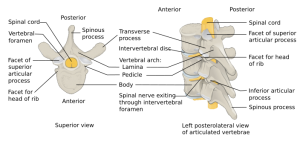Thoracic burst fracture
Background
- Unstable (usually)
- Mechanism: axial loading with flexion compromising anterior and middle column
- Retropulsion of bone causes damage to the spinal canal and neurologic deficits that often cause stable neurologic deterioration.
- Can occur with or without injury to posterior elements (posterior involvement increases risk for neuro deficits)
- Be certain not to mistakenly call a burst fracture a wedge fracture
Vertebral fractures and dislocations types
- Cervical fractures and dislocations
- Thoracic and lumbar fractures and dislocations
Clinical Features
Differential Diagnosis
Thoracic Trauma
- Airway/Pulmonary
- Cardiac/Vascular
- Musculoskeletal
- Other
Workup
- Obtain CT if unsure (vs. wedge)
Management
- Consult Orthopedics or Neurosurgery (Institution dependent)
- Depending on neurologic symptoms and features of the fracture- can be managed nonoperatively




